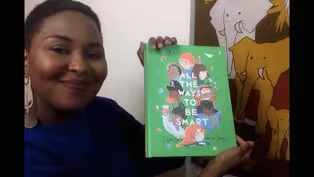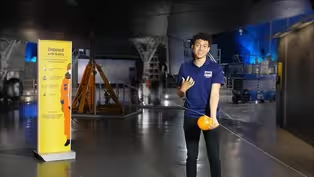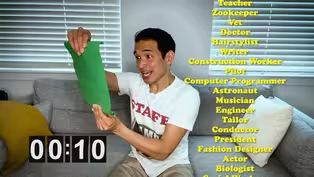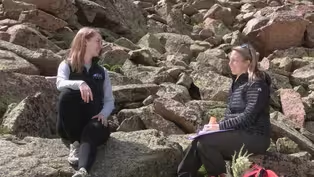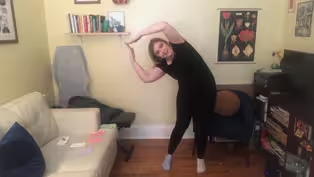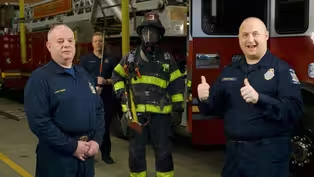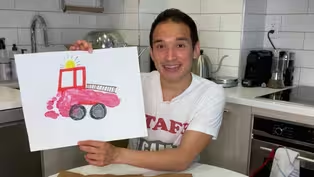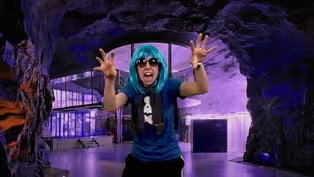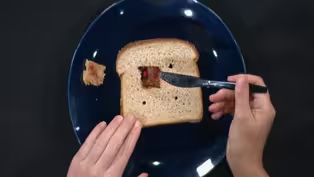
Career Day (Long Version)
7/8/2021 | 56m 46sVideo has Closed Captions
Meet a firefighter and a conservation biologist, make a balloon rocket!
Join head counselor Zach to meet a meet a firefighter and a conservation biologist! Make a balloon rocket and a flip book, do a freeze dance, write hero stories, learn about meerkats and pikas. Content partners include Denver Museum of Nature and Science, Intrepid Sea, Air & Space Museum, NYS Office of General Services, OK Go, Playworks, San Diego Zoo, S’More Ideas, Story Pirates, WFSU.
Problems playing video? | Closed Captioning Feedback
Problems playing video? | Closed Captioning Feedback
Camp TV is a local public television program presented by THIRTEEN PBS

Career Day (Long Version)
7/8/2021 | 56m 46sVideo has Closed Captions
Join head counselor Zach to meet a meet a firefighter and a conservation biologist! Make a balloon rocket and a flip book, do a freeze dance, write hero stories, learn about meerkats and pikas. Content partners include Denver Museum of Nature and Science, Intrepid Sea, Air & Space Museum, NYS Office of General Services, OK Go, Playworks, San Diego Zoo, S’More Ideas, Story Pirates, WFSU.
Problems playing video? | Closed Captioning Feedback
How to Watch Camp TV
Camp TV is available to stream on pbs.org and the free PBS App, available on iPhone, Apple TV, Android TV, Android smartphones, Amazon Fire TV, Amazon Fire Tablet, Roku, Samsung Smart TV, and Vizio.
Providing Support for PBS.org
Learn Moreabout PBS online sponsorship- Hi everybody.
My name is Zach, and welcome to "Camp TV."
[cheerful music] Are you ready for some summer fun?
Me too.
Now, as your head counselor, I will be introducing you to all sorts of cool activities, arts, crafts, games, math and science, as well as some of my favorite books, nature and theater.
I will be here to take you from one activity to the next.
So follow me on "Camp TV."
- [Narrator] This program was made possible, in part, by the Corporation for Public Broadcasting, a private corporation funded by the American people.
Additional funding was provided by the Peter G. Peterson and Joan Ganz Cooney Fund, and the Pine Tree Foundation of New York.
[happy music] ♪ Camp TV ♪ ♪ It's time for us to start ♪ ♪ From furry animal encounters ♪ ♪ To some reading and the arts ♪ ♪ No matter what the weather ♪ ♪ We'll explore it all together ♪ ♪ It's a place for you and me ♪ ♪ It's Camp TV ♪ Oh, hey there.
Huh?
What's that?
[curious music] Uh, hello?
[Zach gasps] Whoa!
I've always wanted to be a firefighter.
[sirens wailing] Whoa!
[radio chattering] Whoa, whoa, whoa, whoa, whoa!
Whoa.
That was weird.
Hmm.
[curious music] Hmm.
Now ladies and gentlemen, prepare to be amazed.
Now you see it.
Now you don't.
- [Audience] Ooh!
- Ha!
Thank you.
Thank you very much.
[audience applauding] [curious music] Hmm.
[Zach blubbering] [jack hammer rattling] Whoa, whoa, easy boy, easy.
Ugh.
[Zach panting] Whew.
Okay.
[curious music] Amazing.
I have created a new color.
I shall call it orange.
Woo.
[cheerful music] Wow.
All of those jobs felt so cool.
And there are so many to choose from.
For now though, this one feels just right.
Welcome to Career Day on "Camp TV."
[whistle toots] Okay, Campers, time to get down to business.
Your job description, being a happy camper.
My job?
Making sure you have fun.
And here's a great way to start.
See you after these next few activities.
[cheerful music] Who's ready for a field trip?
- My name's John Butino.
We're here today to visit our friends from the Albany Fire Department hook and ladder number three.
Come on in.
[happy music] Look at this truck.
Hook and ladder three from the Albany Fire Department.
The truck is so long that it needs two people to drive it.
One to drive and one to steer to get down narrow streets.
The truck is called the hook and ladder because they carry hooks to reach things and ladders to climb things, to reach people in case of an emergency.
Hi, Captain Mike.
What are some of the tools that you use to help keep us safe?
- I'll show you.
These are other tools that we use to force open doors or windows if they are locked.
The ax and the Halligan, sometimes we use the ax to hit the Halligan to open a door or a window.
- Captain Mike, what does this tool do?
- [Mike] It's a thermal imaging camera and it helps us to find somebody in the smoke.
If they're laying on the floor or in a closet.
We are trained to get dressed within under a minute to get our protective clothing on.
First we have our turnout pants.
Our hood that protects our ears and our face, our turnout jacket and our helmet that protects our head.
Also, we have a thing we called an air pack, which has 30 minutes of air so we can breathe in the smoke.
It's important to remember that a firefighter might look different when he has his gear on.
So don't be afraid.
Don't hide.
Don't be scared.
Let him know that you're there.
- Thank you, Captain Mike for the awesome tour of your firehouse.
- You're welcome.
- Here's what you and your family can do to stay safe.
Preventing the fire in the first place is the number one goal.
It's important to also have working smoke detectors, an evacuation plan that you practice with your family, just like at school, with a designated meeting place.
Don't go back in once you're out.
Get out and stay out.
And remember.
- [All] Stay safe.
- [Announcer] Attention all units.
Attention all units.
An alarmed fire is being dispatched for 130 [indistinct] Street.
[drowned out by doors closing and engine starting] [siren wailing] [cheerful music] - [Zach] A little birdie told me it's time to go wild.
- [Rick] Grab your magnifying glass, and let's play zoo detective.
You choose the answer.
Meerkats make us laugh with their alert watchfulness.
Up on two legs and intensely focused, so here's a question.
What word would best describe a meerkat?
A juggler, a statue, a stargazer or a sentry?
Here's a zoo clue.
Meerkats keep a lookout for predators.
The adults take turns acting as a guard so the others can look for food without worry.
Meerkats aren't jugglers or statues that never move.
And they're too busy looking for predators to gaze at stars.
If you said the word sentry best describes a meerkat, then you're a smart zoo detective!
[children cheering] Because a sentry is a soldier stationed to keep guard.
This member of the mongoose family lives in a community called a gang or a mob of up to 40 members.
So they have safety in numbers and a sentry on duty.
[cheerful music] - [Zach] It's time to get active.
Let's move.
- My name is Mackie, And I work at the Children's Museum of the Arts in New York City.
And I'm so excited you all have joined us for creative movement today.
Now it's time to explore some lines and shapes with our body.
So here I have some flashcards with different lines and shapes on them.
And when I pull out a flashcard, I'll show it to you so you can see it.
And then I want you to trace out or make that shape with your body.
So here's an example.
Let's try it.
We'll start off pretty easy with a circle shape.
[peaceful music] How can you make a circle with your body?
How can we make a circle?
First, we could start making a circle with our arms, as much of the circle, or there we go, that we could make it with our arms.
Or even down here in front of us or to the side.
Now, let's put our hands together and trace a big, big circle in the air using every part of our body, like our fingers are pencils, and we're drawing a big, big circle in the air.
Let's try it.
Starting really low and working our way all the way up with our big, big circle all the way around.
Nice job with our big circle.
All right, what kind of line or shape will be next?
What about a zigzag line?
How can you make a zigzag line with your body?
Make it like zigzagging like that?
Even use your, using your legs you can make a zigzag line.
Little bit.
Now let's clap our hands together, and let's trace a big, big zig-zag line in the air.
You can start, start up high, tracing that zigzag through the air with our really pointy parts of that line, right?
Zigzags are pointy.
Awesome job.
Let's see what's next.
Okay, the opposite of a zigzag comes a smooth squiggly line.
How can we make a squiggly line with our body?
A really smooth line, moving really smooth back and forth like our squiggly line.
Clap our hands together if you haven't already, and let's trace that big, big squiggly line in the air.
Squiggly line, different from our pointing line, right?
Tracing that in the air all the way down to the ground.
Now let's go from the ground back up.
Squiggle our line and make it really big.
All the way up.
Nice job.
Let's see what's next in our line flashcards.
Oops.
We have three lines that make up a shape, and that is a triangle.
How can we make a triangle with our body?
I think I would maybe start making my bottom half small and a triangle like this over my head.
You can try to make a triangle sideways.
Ooh, straighten it out.
There you go.
Let's trace a big, big triangle like our hands are pencils and we're tracing that triangle in the air.
Hands come together.
Let's start up at the top.
Triangle up here, all the way down, across and back up again.
Nice job, everybody, with our lines and shapes flashcards.
- Welcome back to Career Day on "Camp TV."
Have you ever thought about what you might want to be when you grow up?
Okay.
I know what you're thinking.
Hey Zach, I'm just a kid!
And you'd be right.
But I say it is never too early to learn something new about yourself or the world.
Most people need to work to earn an income, money to support themselves and their families.
But my wish for you is one day you will have a career you not only need but love.
And the good news is, the world is full of possibilities, and you are full of unique talent.
So how do you choose?
Well, start by paying attention to the things you already like to do.
Do you like solving problems, talking to new people?
What are some of your favorite subjects in school?
Do you like to write, perform science, experiments, play an instrument?
What about your hobbies?
Do you like to draw, cook, play sports, build things?
You can also ask the adults in your life about their jobs.
Or just take a walk around your neighborhood and notice all the different stores and jobs.
The clothes you wear, the crayons you draw with, the books you love, they've all been made by teams of people working together to get the job done.
With some careful planning, hard work, education, training and time, know that there's a job out there that's just waiting to be discovered by you.
[cheerful music] Curiosity and wonder, let's discover together.
It's science wow!
- Hello, everyone.
Welcome to the Intrepid Sea, Air and Space Museum.
My name is Jonathan Milard, and I'm a museum educator.
Today, we're going to explore this awesome object behind me, the Space Shuttle Enterprise.
And we're also going to make our very own balloon rocket.
So the Space Shuttle Enterprise is the very first space shuttle ever made.
Space shuttles are essentially like space trucks.
The astronauts, or drivers, can fit in the front, and all the stuff that's going up into space can fit in the back.
So the space shuttle can carry very large things inside like telescopes and satellites.
And these telescopes and satellites could be the size of an entire school bus.
So, looking at this space shuttle here, you probably have an idea that this is very, very large.
It's more than 130 feet long, and it weighs more than 150,000 pounds.
Just this space shuttle orbiter that we see behind us here.
So when a space shuttle is getting ready to go into space, it's actually attached to all these objects here.
And this is what's going to help the space shuttle blast off and go up into space.
To bring a space shuttle up into space, you need a lot of fuel.
So attached here to our space shuttle you see this liquid fuel tank and the solid rocket boosters on the side.
And what these solid rocket boosters and this liquid fuel tank attached to the main exhaust of the space shuttle will do is they'll push a lot of force downwards to help the space shuttle go up.
So I want you guys to think, have you ever gone swimming or have you ever seen a video or photos of people going swimming?
You might see them doing something a little bit like this, maybe something like this.
And as they're doing that, they're pushing water behind them.
And as you push water behind you, what direction do you think you'll go?
If you push water behind, what direction will you go?
The answer is forwards.
For every action, there's an equal and opposite reaction.
We push that water back, we're going to go forwards.
In this case, the space shuttle is going to push force downwards, and it's going to help that space shuttle go upwards.
So what we're going to do in a bit is create our very own balloon rockets.
And with those balloon rockets, we're going to experiment with some fuel and see how far we can have those balloon rockets go.
So to make your very own balloon rocket, we're going to need a few different materials.
One thing we need is a balloon.
Then we're going to need a long piece of string, some tape, some scissors and a drinking straw.
So what you're going to want to do is actually cut that drinking straw in half, because we're going to want a smaller straw for our activity today.
So what we're going to do with our string is we're even going to attach one end to a high surface or to a chair.
We can use our piece of tape to secure one end of our very long string to that object.
Another idea is to have someone hold that string.
Then what we're going to do is thread our straw onto the string.
So my straw is there right over here.
And I just threaded it alongside the string.
And then we want to add a piece of tape on top of this straw.
We're adding a piece of tape on top of this straw.
The next thing we're going to do is grab our balloon.
And our balloon is what we want to zoom along this string here.
And to make that happen, we need to give this balloon some fuel.
And what do we think that fuel might be?
[gentle guitar music] That fuel might be air.
So we're going to use air to inflate this balloon and help this balloon move along this string.
So let's inflate the balloon.
And I'm going to inflate my balloon just about this size.
You can make it bigger.
You can make it a little bit smaller.
And we want to attach this balloon to that straw.
So we're going to take that tape there and attach our balloon to that straw.
And then we're going to release this balloon along this string, and we're gonna see how far it goes.
So I'm going to release this balloon in a bit, and I want a little bit of help as we make this balloon blast off.
So what we're going to do, we're actually going to count down together.
So can you give us a countdown?
Can you give us a three, a two, a one, and blast off.
So you might have noticed, my balloon went a certain distance on the string, but let's see if we can make your balloon go even farther.
Let's see what might happen if you put less fuel inside that balloon.
Keep experimenting and have a lot of fun with this project.
Thank you so much for joining us today.
I had a great time working with you all.
Thank you so much.
[cheerful music] - [Zach] You took the words right out of my mouth, write on.
[exciting music] - Let's talk about the big moment.
The moment of maximum danger and suspense.
The whole community is about to be in big trouble.
We need a hero to answer the call!
[heroic music] For a hero story, you need a hero-sized problem, a problem so huge that it threatens a whole community.
A problem so huge that only a hero can step up and solve it.
- Ha!
I am the villain, and I am here to get the hero.
Ha!
- No!
Nope, not a big enough problem.
- Uh, what?
- If you've got a personal problem with the hero, take care of it on your own time.
This is not a story about two people gettin' in a fight.
This is about a hero-sized problem where a hero has to help a whole community.
- Ugh, I'll get you, hero.
- Most of the biggest problems in the world are not caused by one bad guy who's up to no good.
And your story will be most interesting if you focus first on making the problem huge.
So how do you come up with a hero-sized problem?
Maybe you have an idea already.
You could write about a volcano.
- Oh, no.
The volcano has erupted.
[yells] - Or a flood of pudding.
- Oh, no.
It's pudding, and it's everywhere.
- Or something really, really weird that nobody has thought of yet.
- Worms are falling from the sky!
- Or here's another way to come up with a hero-sized problem.
Start with a small problem.
- Ouch!
A squirrel just bit my toe.
- Then make it bigger.
- Ouch, ouch!
Oh, no.
Squirrels are biting everybody's toes in the city!
- And bigger until it's so big, a hero needs to get involved.
- Ah!
Squirrels have taken over the entire city!
They've taken over the library!
They've taken over the school!
They've taken over the television stations!
- Try that with any problem you want.
Start with a really tiny problem, then have fun turning it into a gigantic problem.
Just make sure that eventually it's so big, a hero has to step in and help out a whole community.
And remember, leave the villain out of it for now.
- You haven't heard the last of me!
- [Zach] Music, dance, magic and more.
Step right up to center stage.
[melancholy music] ♪ You're the engine that makes all things go ♪ ♪ And you're always in disguise, my hero ♪ ♪ I see your light in the dark ♪ ♪ Smile on my face when we all know it's hard ♪ ♪ There's no way to ever pay you back ♪ ♪ Bless your heart, know I love you for that ♪ ♪ Honest and selfless ♪ ♪ I don't know if this helps it ♪ ♪ But good job ♪ ♪ You're doing a good job, a good job ♪ ♪ You're doing a good job ♪ ♪ Don't get too down ♪ ♪ The world needs you now ♪ ♪ Know that you matter, matter, matter, yeah ♪ ♪ You're doing a good job, a good job ♪ ♪ You're doing a good job ♪ ♪ Don't get too down ♪ ♪ The world needs you now ♪ ♪ Know that you matter, matter, matter, yeah ♪ ♪ Six in the morning ♪ ♪ And soon as you walk through that door ♪ ♪ Everyone needs you again ♪ ♪ The world's out of order ♪ ♪ It's not as sound when you're not around ♪ ♪ All day on your feet ♪ ♪ Hard to keep that energy, I know ♪ ♪ When it feel like the end of the road ♪ ♪ You don't let go ♪ ♪ You just press forward ♪ ♪ You're the engine that makes all things go ♪ ♪ Always in disguise, my hero ♪ ♪ I see your light in the dark ♪ ♪ Smile in my face when we all know it's hard ♪ ♪ There's no way to ever pay you back ♪ ♪ Bless your heart, know I love you for that ♪ ♪ Honest and selfless ♪ ♪ I don't know if this helps it ♪ ♪ But Good job ♪ ♪ You're doing a good job, a good job ♪ ♪ Good job ♪ ♪ You're doing a good job ♪ ♪ Don't get too down ♪ ♪ The world needs you now ♪ ♪ Know that you matter, matter, matter, yeah ♪ ♪ Yeah, good job ♪ ♪ You're doing a good job, a good job ♪ ♪ Ooh yeah ♪ ♪ You're doing a good job ♪ ♪ Don't get too down ♪ ♪ The world needs you now ♪ ♪ Know that you matter, matter, matter, yeah ♪ ♪ The mothers, the fathers, the teachers that reach us ♪ ♪ Strangers to friends that show up in the end ♪ ♪ From the bottom to the top, the listeners that hear us ♪ ♪ This is for you, you make me fearless ♪ ♪ You're doing a good job, a good job ♪ ♪ Oh ♪ ♪ You're doing a good job ♪ ♪ Don't get too down ♪ ♪ The world needs you now ♪ ♪ Know that you matter, matter, matter, yeah ♪ - [Choir Member] Thank you so much to our first responders, our health care workers, our mothers.
- [Girl] Thank you to our moms and our dads.
- [Young Woman] Thank you to our teachers, who've helped us.
- [Young Man] We know it's been hard, but thank you.
- Thank you.
- Thank you.
- Thank you.
- Thank you.
- [Boy] Thank you, good job.
- And you're back!
Welcome.
In honor of Career Day on "Camp TV," today's Zach Challenge is brought to you by every career under the sun.
I will have 15 seconds to get through a list of jobs I've considered and you might want to consider one day too.
Ready?
- [Children] Three, two, one.
- Teacher, zookeeper, vet, doctor, hairstylist, writer, construction worker, pilot, computer program, astronaut, musician engineer, tailor, conductor, president, fashion designer, actor, biologist, social worker, illustrator, real estate agent, a historian, toy designer, nurse, dentist, mathematician, firefighter, baker, store manager.
Oh, whoa!
[buzzer buzzes] So many career choices, so little time.
Woo!
I need to take a breather.
See you soon.
[cheerful music] Arts and crafts?
Yes, please.
Let's get artsy.
[rock music] - For the beginning of our video "The One Moment," I began with a giant flip book, and actually we have it here.
Whoa, it's really heavy.
And as you can see, when you pull back the pages, you can see Damian lip-syncing.
It's hard to do 'cause it's so thick.
But this flip book was made for me.
I didn't make it myself, and I actually don't know how to make a flip book, but Dan does.
- I do.
- All right, so can you show me how to make a flip book?
- Absolutely.
- All right.
- The general idea of a flip book is you have these still images, and over the course of the flip book, they progress very, very subtly between each one.
And if there's a continuity between all the pictures, it gives you a sense of movement as you flip the book.
So I think a good place to start is just think simply, and we'll just make a line travel across the notepad.
- Okay.
- It's pretty fun.
It takes a while, but it's fun to do.
And as we go through this, we can do more complex things.
- Okay, I don't draw very well.
So but that's okay.
- No worries.
It's fine.
So the very first page, I think the way to start, flip kind of closer to the end so like right about there, and we're gonna start there.
The flip book is gonna work this way.
And you're gonna see the animation like that.
- Okay.
- Okay?
So you start on the right side of the page.
And you make a little line like that, right?
The next page you drop down the next piece of paper - Oh, then I can see- - [Dan] You can see where it was, and we make that line inch across the page.
The same level that you're at.
- So basically right there.
- [Dan] Yeah.
That's perfect.
- Okay.
Oh, this is easier than I thought.
- Yeah, this is an easy one to do.
And I like to call this one flying arrow.
Oh, do you?
- Flying arrow.
This is the name of this book.
- Oh, that's nice.
- So you you'll see how it feels that way when we're done.
[rock music] So let's see yours.
Let's see how yours is.
- All right.
So let me.
It works.
- Okay.
- Just not well.
- Okay, that's fine.
- All right.
Let's see how it moves.
Let's see yours.
- I'm gonna show you how mine looks.
- What's it called, flying arrow?
- Flying arrow.
- Oh, the master.
- Thank you.
It'd be kind of cool to move on to maybe a little bit more complex idea.
- All right, that's all you.
- Yeah, yeah, yeah.
- All right.
- I need for you to sort of be a model for a minute.
- That's easy.
- Okay.
- Okay.
- Can you walk in place?
- Yeah.
- Okay.
- Like stand up and walk?
- Yeah, yeah.
- Okay.
- But like don't move.
Don't walk around the room.
Just stand in one spot and walk.
- Yeah, I got you.
Okay.
- [Dan] Let me see how this looks.
- All right.
So, okay.
I'm walking.
- [Dan] Good.
- Kinda like that.
- Yeah.
That's it.
- Right?
- Okay.
- Is this helpful?
- Yeah.
There's like a one main line, which is your head, body and legs, and these like two triangles are right angles that are kind of swishing back and forth, and kind of like two triangles kind of going up and down down here.
So I can reduce you to a stick figure in my mind.
- Okay.
You wouldn't be the first.
[rim shot] - These Post-it Notes are fine, but they're kind of not durable.
- Yeah, they're flimsy.
- They're flimsy and they fall apart.
So what we're gonna do is use a binder clip and put it on the edge of a stack of note cards.
And the whole thing kind of feels better.
- Oh, I see.
- It's a little bit stronger.
- [Tim] Okay, sturdier.
- We're gonna make this stick guy walk in place, just like how you were doing it a second ago.
And so we've got this, the head of the guy right there.
This is your head.
- That's me?
- Yeah, this is you.
This is your torso.
And here are your two legs, right?
- You really, you're getting the essence of me.
- Yeah, this is it, running man.
Well, walking man.
- Walking man.
- [Dan] And for the arms, we're gonna just do little- - Triangles.
- Triangles.
Or like little straight edges.
Not quite straight, but you know.
That's you.
- That's me, clearly.
- That's just you, that's you in mid walk.
So we follow it up with another one in the exact same spot, but now we make the legs move a little bit more.
- Okay.
- And the arms go up a little bit more.
- Okay.
- Okay?
- [Tim] So he's gonna stay right in the center.
- [Dan] That's right.
- And he's just gonna keep moving.
- And the way that I change the position of the arms over time will make it look like you're moving in place.
- Okay, cool.
[rock music] - Okay, Tim, I got somethin' to show you.
- Okay.
- It's taken a while.
- Okay.
- We've been here for like five days.
- [laughing] Yeah.
I haven't showered.
- But I have a flip book I want to show you.
- Okay, great.
- What I thought was gonna be walking man turned into dancing, freaking out running man.
- Okay.
- But so check this out.
- All right.
I mean, it's not what you set out to do, but it's pretty cool.
- Right.
It's joyful.
- Yeah.
- So I think what we ought to do is add something.
- [Tim] Okay, cool.
- I'm gonna put maybe you in an environment that sort of reflects what the spirit of this is going.
So I'm going to add maybe some sparkles or fireworks or something.
- Some kind of party to it?
- Yeah.
- Okay, cool.
[dramatic music] - So I've got a finished book here.
- Awesome.
- All right, you want to see it?
- Yeah, totally.
- Okay, here we go.
One more time.
- Yeah.
- Awesome.
- Yeah, that's awesome.
I noticed when you flip fast, it looks like things are definitely moving.
If you go a little slower, it doesn't look like things are moving as much.
It looks weird.
Do you know why?
- I'm not totally sure why.
But I noticed that too.
- Yeah?
- Yeah.
- Hmm.
All right, well, I don't know.
Maybe you guys can figure it out.
[rock music] [cheerful music] - [Zach] It's time to get active.
Let's move.
- When you're out on the field or on the court, you need to be able to run fast, and then even faster.
Bottom kicks help pump up your hamstrings and give you explosive speed.
Let's do some bottom kicks.
Start by going into a light jog, nice and easy.
Then you want to step that jog up to a sprint.
Staying in place, staying neutral.
To add the bottom kicks, you're gonna place your hands right behind your glutes, that's your bottom, then you're gonna pump your feet up and kick each hand.
[upbeat music] All right, kick.
You want to go slow and then fast.
Nice and easy.
Right?
We're gonna do a power blitz.
That's one minute of bottom kicks.
I'm going to do them with you as well.
All right?
So no fear.
Let's get it done together.
You ready?
We're gonna start jogging in three, two, one.
[horn blasts] Kick it up to a sprint.
Good.
Hands behind your bottom.
Kick.
♪ Drop it ♪ - Nice and easy.
[upbeat music] All right, kick.
Nice and easy.
Come on, you got it.
Pick up the pace.
♪ Drop it ♪ - Here we go.
Hang in there.
Come on.
Almost there.
Keep kicking.
Finish line is in sight.
And we're gonna come to a stop in five, four, three, two.
[bell dings] [crowd cheering] Yeah.
That's the way to work.
Way to get those bottom kicks in there.
Keep working on those.
Keep those hamstrings pumping and keep improving.
I'll catch you next time.
- Hi again.
[cheerful music] Have you ever noticed how certain careers require specific equipment to get the job done?
For example, firefighters need fire trucks.
Farmers need tractors.
Ice cream truck drivers need ice cream trucks.
So in honor of those hardworking vehicles, let's take a step in the right direction.
Today, we're turning our footprints into a favorite worker vehicle.
Get ready because this is going to get a little bit messy.
You will need a piece of construction paper, some markers, a paintbrush, and, depending on the vehicle you choose, a different colored non-toxic paint.
So you don't get paint on the floor by mistake, put something down an adult says is okay to use to protect it.
Next, place a piece of construction paper that is big enough for your foot, and put it on top of it.
While sitting on a chair, paint the bottom of one of your feet.
[giggles] It tickles.
I'm using red because I'm making a fire truck.
Make sure not to use too much paint.
You don't want it to drip.
Carefully, with your painted foot not touching the ground, stand up, place your foot horizontally on the paper and make a footprint.
Gently lift your foot off the page to avoid smearing.
Have a wet towel close by, ready to wipe your foot once you are done making the print.
Allow your foot and your footprint to dry completely.
Next, draw the fire truck with a ladder, a siren and anything else you'd like.
[light fun music] Let everything dry.
And there you have it.
How cute is that?
Hmm, I think I'll turn mine into a card and send it to a local fire station near me.
I want to thank them for helping keep our neighborhood safe.
They definitely deserve a hand.
And now, they'll have a foot too.
[cheerful music] Curiosity and wonder, let's discover together.
It's science wow!
- My name is Barbara Clark, and I'm with the Florida Public Archeology Network.
And today we're going to be doing peanut butter and jelly archeology.
Now, first we need to understand what archeology is.
It's the study of people from a long time ago.
And we study them by looking at the things they've left behind.
Those are artifacts.
Now, when you're digging in the dirt, the deeper something is underground, the older that something is.
And that goes for artifacts as well.
Now that is called stratigraphy.
So today we're going to be using stratigraphy both in our excavation techniques, but also we're gonna be creating our archeology site.
So let's get started, and you'll see exactly how stratigraphy works.
So this is a field a long, long time ago.
Now this field is next to a river.
That river floods, and it leaves a layer of mud.
Now we're gonna use our peanut butter as our mud, because can't have peanut butter and jelly archeology without some ooey, gooey peanut butter.
So here's our layer of mud that's been left.
Now, along come a group of people that are wanting to fish on that river.
Now, they are gonna spend the night, so they need to have a campfire to keep warm.
We're gonna use some chocolate chips as our campfire.
Now, you can use whatever you have around the house.
All right, here is our little campfire.
Of course, you can't have a campfire without some yellow flames.
So here's our yellow flames.
Now, after these people are done camping for the night, they go on their way.
And over time, a layer of dirt is deposited on top of the site.
It's still there.
We just can't see it anymore.
Now, years later, a new group of people come along, and they decide they want to build their houses there and stick around for a little bit.
So they're gonna build their houses by creating what we call little post holes.
And in these post holes, that's where they would put the posts for their house.
See, we have four there to represent four corners of their house.
Now, the wood that would be used for those posts rots away, and it leaves a stain in the soil.
Archeologists call that a feature.
Now, since they're going to be sticking around for awhile, they're gonna be making a lot of garbage.
They didn't have garbage collection like you and I do.
They wouldn't dig a hole, and in that hole, they would put their trash.
Their trash would consist of broken pieces of pottery, animal bones, fish bones, all the things that they would have used and eaten and made.
Put some red candy in there too.
that maybe they're a little bit too close to the river.
Now, over time, the river starts rising, and they realize that maybe they're a little bit too close to the river.
So they move on their way.
Good thing they did, because the river does indeed flood.
And it deposits another layer of mud.
This time we're going to be using the jelly, because, of course, you need both peanut butter and jelly.
Now, you'll notice that some of my artifacts are moving around, and that's okay.
That's what we call redistribution.
And it does happen in real life.
And you'll notice too that my little postholes are all filled in.
So these folks have moved on their way.
Their homes flooded.
Uh oh.
And over time, more soil is deposited on top of the site.
Now there's a lot going on there, but now you can't see it because it's covered in dirt right?
So as an archeologist, we're gonna switch gears a bit, and now we're going to excavate the site.
We're gonna dig the site and see what's under there.
The first step is doing what we call shovel testing, and that's just putting holes in the ground to see what's there.
So we're gonna use a straw, and I like to use a clear straw because then you can see the stratigraphy in the straw a little bit.
[wondrous orchestral music] So we have some peanut butter and a little bit of jelly.
We're gonna put a couple of holes in, see what we come up with.
I feel like I hit something hard on that one.
Let's see.
[gentle guitar music] More jelly.
Let's do a couple more holes, see what we come up with here.
Now, I hit something hard over there, which makes me think there's something.
More jelly.
Lots of jelly.
It must have been a very bad flood.
And more jelly.
So I want to dig a larger hole right here where I felt something when I put my shovel in the ground.
So I'm gonna dig a little hole.
Now, archeologists dig what are called excavation units.
And these are the square holes that you see if you've ever seen a photo of an archeological site.
Now, when we're digging, archeology is a destructive science.
We're actually destroying the site as we study it.
So we have to work really carefully and really slowly.
So we'll take notes.
We'll make photographs, draw pictures.
And when we excavate, we do so layer by layer.
And oh my goodness, it looks like we hit the jackpot.
We have the candies.
It looks like we hit our mittens.
So this would give us a lot of information about people that live there, 'cause you can learn a ton by studying people's garbage, 'cause that's what they live and use every day.
So there you go.
Now, next time you eat a peanut butter and jelly sandwich, you too can be an archeologist.
[cheerful music] - [Zach] A little birdie told me it's time to go wild.
- Welcome to Loveland Pass, Colorado, 12,000 feet above sea level.
I'm standing on top of the Continental Divide in an extreme habitat where no trees can grow.
Up here in the Alpine Tundra, scientists are teaming up with members of the general public to study the American pika as part of their Front Range Pika Project.
Here with me today is Erica Garroutte, conservation biologist and co-director of the Front Range Pika Project.
Erica, can you... [question mark pops] Erica?
Erica?
Erica?
[bell dings] Oh, there you are.
- Oh hi, Talia.
How's it going?
- Oh, it's going great.
Um, what are you doing?
- Oh, you know, just collecting some pika poop.
Just a typical Friday.
- Okay.
Definitely have some questions for you about that one.
But for now, it seems like you have a really cool job as a conservation biologist.
- Yeah, I think so.
- Can you tell me what a conservation biologist does?
- Sure.
Conservation biologists study animals, plants and their habitats or their homes.
And we study them throughout time and over large areas.
And by studying their populations over time, if we notice that their populations are potentially declining, then we can come up with strategies to help protect them.
- So when you say that you work with and protect animals, does that mean you work with animals all over the world?
- Yeah, as a conservation biologist in the field conservation department at the Denver Zoo, we protect animals all over the world.
We study and we protect bison down in New Mexico.
We study and we protect argali sheep and wild hedgehogs and hamsters in Mongolia.
We work with lake Titicaca frogs in Peru and also Tonkin snub-nosed monkeys in Vietnam.
And we also work with vultures in Botswana.
- It seems like a super cool job.
I gotta be honest there.
So you also work here in Colorado, right?
What are we doing up here in the Alpine?
- Yeah, so one of the projects that we work on is called the Front Range Pika Project, where we study pikas, which you might see running around the talus here.
They're tiny little animals.
We say that they're about the size of a potato, and they don't have any tails, but they have huge ears.
And they live in this talus.
And they're really unique, because, unlike a lot of animals that live in these extreme Alpine environments, they don't hibernate.
And so they have a lot of unique characteristics that allow them to survive in these pretty extreme conditions.
- So, Erica, how did you end up with such a cool job?
Did you have to go to school for a long time?
- When I was a kid, I grew up here in Colorado.
I liked to spend a lot of time outside.
I was always excited to play in my backyard, on the playground.
And I was always curious about the animals that I saw in my backyard.
I didn't always like science class though, 'cause it seemed like there was a lot of reading, a lot of textbooks.
But as I continued to study science throughout elementary school and middle school, I realized that scientists actually go spend a lot of time outside observing animals.
And that's when I decided that I wanted to be a scientist.
- Well, did you have to go to college or graduate school and do more learning to become a scientist?
- So I studied biology when I was in high school, and I took a lot of extra classes so I could actually get outside.
I learned that if you're a biologist, you actually, instead of sitting in the classroom, you do go outside a lot, which was great for me, because recess was one of my favorite classes.
And then I went on and I studied biology in college.
And then I decided that I wanted to do more detailed research, and so I moved on to graduate school, where I studied ecology.
- Now, do you need to go to school for a long time to be part of conservation work?
Or can anybody be part of meaningful change?
- Anybody can be a part of the conservation of wildlife.
In fact, we need more artists, we need more photographers.
We need more accountants helping us with conservation work.
And anybody can help with conserving pika.
As part of the Front Range Pika Project, we have average citizens coming up here helping us make observations about what's happening with these pika populations.
And that data is really important for us because biologists can't get out to all of these sites.
So we need the help of average citizens who are up here hiking to help us collect the data that we need to protect these species.
- Well, Erica, thank you so much for being here to talk with us today.
While we're out here, should we go collect some more data?
- Sure, that'd be great.
Do you mind helping me?
- Oh, absolutely, happy to do it.
- Perfect.
- Well, thank you everybody for watching.
We're going to go collect some more data.
Let's go.
- Let's go - [Zach] Daytime or nighttime, it's always time for story time.
- Hi, friends.
My name is Jasmine Wilson.
And today, we're going to read "All the Ways to Be Smart" by Davina Bell and Allison Colpoys.
Did you know that there are so many ways that you can be smart beyond what you learn in a classroom?
What are some things that you're really good at?
I bet that we're going to learn even more things that you can do.
That's super smart.
I can't wait to share with you how smart you are the whole day through.
Smart at drawing witches hats.
Smart at gluing wings on bats.
Smart at rhyme and telling time and building cubbies, making slime!
Have you ever made slime?
It's so much fun, highly recommend it with a trusted adult.
Smart is not just ticks and crosses.
Smart is building boats from boxes, painting patterns, wheeling wagons, being mermaids riding dragons!
How many of you would love to ride a dragon?
I sure would.
Smart at drawing things with claws, facts about dinosaurs, folding airplanes for flying.
Smart is kindness when there's crying.
Growing, throwing, bubble blowing.
Smart is knowing where you're going.
Finding treasures, flower picking, ukulele, finger clicking.
[fingers snap] You know what?
I would love to play the ukulele.
That would be super fun.
Smart at sharing, caring, scaring.
Smart at picking what you're wearing.
Today, I'm wearing purple, because it's one of my favorite colors.
What's your favorite color?
And are you wearing it today?
Hmm, I wonder.
Smart at saying hi and bye to people when they feel all shy.
Sometimes I feel shy, and I like it when someone says hello to me.
Or maybe you're somebody who likes saying hello to other people, and you help others feel more welcome when they're feeling a little shy.
Crazy dances, horsey prances, feeling scared but taking chances.
Jumping off so you can fly!
Smart at asking how?
What?
Why?
Smart at building ships to Mars, drawing very pointy stars.
Knowing all the planet names.
Making space suits that shoot flames.
I love to stargaze and imagine what it would be like to float through space like these kids.
Smart at matching shapes in pairs like hexagons and big blue squares.
How many sides do a hexagon have?
Well, hexagons has six sides and squares have four.
Counting all the ways past 40.
Being sorry, when you're naughty.
It's not as much fun, but it's always important to admit when you are sorry.
We make mistakes, and we can learn from them.
And then we continue.
Smart at bugs and squeezy hugs and mixing potions up in mugs.
Ooh.
Making up new games with teams.
Which team would you like to be on?
There's one with an owl and a bear.
And there's one with a turtle and a raccoon.
Oh my goodness.
This is, this looks like some fun teams to be on.
And floating off on daytime dreams.
How peaceful is it sometimes to just go out in nature, next to a water or some grass.
Smart is reading, writing, spelling, but it's also storytelling, like we're doing now.
Finding things on all the pages.
Oh my goodness, look at how big this book is!
That book is bigger than the kids.
That must be a really good story.
Very lifelike.
Sitting still and quiet for ages.
Smart is not just being best at spelling bees, a tricky test or knowing all the answers ever.
Other things are just as clever.
Every hour of every day, we are smart in our own special way, and nobody will ever do the very same smart thing as you.
The end.
That was "All the Ways to Be Smart" by Davina Bell and Allison Colpoys.
See you next time.
Bye.
[cheerful music] [happy music] ♪ Camp TV, time for us to part ♪ ♪ From furry animal encounters ♪ ♪ To summer reading and the arts ♪ ♪ No matter what the weather ♪ ♪ We'll explore it all together ♪ ♪ It's a place for you and me ♪ ♪ It's Camp TV ♪ - [Narrator] This program was made possible, in part, by the Corporation for Public Broadcasting, a private corporation funded by the American people.
Additional funding was provided by the Peter G. Peterson and Joan Ganz Cooney Fund and the Pine Tree Foundation of New York.
Content provided by these institutions.
[cheerful music] [electronic music]
Video has Closed Captions
Clip: 7/8/2021 | 6m 8s | Jasmine reads "All the Ways to Be Smart" by Davina Bell. (6m 8s)
Video has Closed Captions
Clip: 7/8/2021 | 4m 39s | Learn how the space shuttle Enterprise would launch into space. (4m 39s)
Video has Closed Captions
Clip: 7/8/2021 | 2m 13s | Follow along with Malcom for one minute of bottom kicks in this video from Camp TV! (2m 13s)
Video has Closed Captions
Clip: 7/8/2021 | 51s | In just 15 seconds, Zach names all of his possible career choices. (51s)
Video has Closed Captions
Clip: 7/8/2021 | 4m 18s | Meet a Conservation Biologist in this video from Camp TV! (4m 18s)
Video has Closed Captions
Clip: 7/8/2021 | 3m 48s | Creative movements with Mackie. (3m 48s)
Video has Closed Captions
Clip: 7/8/2021 | 2m 14s | Visit a fire station and learn about fire safety with this video from Camp TV. (2m 14s)
Video has Closed Captions
Clip: 7/8/2021 | 2m 8s | Follow along as Zach creates a vehicle painting with his foot! (2m 8s)
Hero Stories – Hero-Sized Problems
Video has Closed Captions
Clip: 7/8/2021 | 2m 36s | Learn to make your story compelling in this Story Pirates writing segment. (2m 36s)
Video has Closed Captions
Clip: 7/8/2021 | 6m 28s | Learn about archeology with this video from Camp TV! (6m 28s)
What Do You Want to Do When You Grow Up?
Video has Closed Captions
Clip: 7/8/2021 | 1m 36s | Zach teaches us the importance of careers. What would you like to do when you grow up? (1m 36s)
Providing Support for PBS.org
Learn Moreabout PBS online sponsorshipSupport for PBS provided by:
Camp TV is a local public television program presented by THIRTEEN PBS
